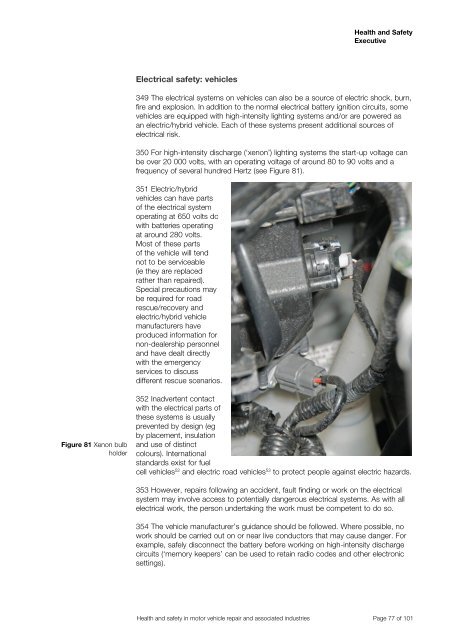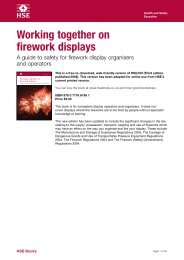Health and safety in motor vehicle repair and associated industries
Health and safety in motor vehicle repair and associated industries
Health and safety in motor vehicle repair and associated industries
Create successful ePaper yourself
Turn your PDF publications into a flip-book with our unique Google optimized e-Paper software.
Figure 81 Xenon bulb<br />
holder<br />
Electrical <strong>safety</strong>: <strong>vehicle</strong>s<br />
<strong>Health</strong> <strong>and</strong> Safety<br />
Executive<br />
349 The electrical systems on <strong>vehicle</strong>s can also be a source of electric shock, burn,<br />
fire <strong>and</strong> explosion. In addition to the normal electrical battery ignition circuits, some<br />
<strong>vehicle</strong>s are equipped with high-<strong>in</strong>tensity light<strong>in</strong>g systems <strong>and</strong>/or are powered as<br />
an electric/hybrid <strong>vehicle</strong>. Each of these systems present additional sources of<br />
electrical risk.<br />
350 For high-<strong>in</strong>tensity discharge (‘xenon’) light<strong>in</strong>g systems the start-up voltage can<br />
be over 20 000 volts, with an operat<strong>in</strong>g voltage of around 80 to 90 volts <strong>and</strong> a<br />
frequency of several hundred Hertz (see Figure 81).<br />
351 Electric/hybrid<br />
<strong>vehicle</strong>s can have parts<br />
of the electrical system<br />
operat<strong>in</strong>g at 650 volts dc<br />
with batteries operat<strong>in</strong>g<br />
at around 280 volts.<br />
Most of these parts<br />
of the <strong>vehicle</strong> will tend<br />
not to be serviceable<br />
(ie they are replaced<br />
rather than <strong>repair</strong>ed).<br />
Special precautions may<br />
be required for road<br />
rescue/recovery <strong>and</strong><br />
electric/hybrid <strong>vehicle</strong><br />
manufacturers have<br />
produced <strong>in</strong>formation for<br />
non-dealership personnel<br />
<strong>and</strong> have dealt directly<br />
with the emergency<br />
services to discuss<br />
different rescue scenarios.<br />
352 Inadvertent contact<br />
with the electrical parts of<br />
these systems is usually<br />
prevented by design (eg<br />
by placement, <strong>in</strong>sulation<br />
<strong>and</strong> use of dist<strong>in</strong>ct<br />
colours). International<br />
st<strong>and</strong>ards exist for fuel<br />
cell <strong>vehicle</strong>s 52 <strong>and</strong> electric road <strong>vehicle</strong>s 53 to protect people aga<strong>in</strong>st electric hazards.<br />
353 However, <strong>repair</strong>s follow<strong>in</strong>g an accident, fault f<strong>in</strong>d<strong>in</strong>g or work on the electrical<br />
system may <strong>in</strong>volve access to potentially dangerous electrical systems. As with all<br />
electrical work, the person undertak<strong>in</strong>g the work must be competent to do so.<br />
354 The <strong>vehicle</strong> manufacturer’s guidance should be followed. Where possible, no<br />
work should be carried out on or near live conductors that may cause danger. For<br />
example, safely disconnect the battery before work<strong>in</strong>g on high-<strong>in</strong>tensity discharge<br />
circuits (‘memory keepers’ can be used to reta<strong>in</strong> radio codes <strong>and</strong> other electronic<br />
sett<strong>in</strong>gs).<br />
<strong>Health</strong> <strong>and</strong> <strong>safety</strong> <strong>in</strong> <strong>motor</strong> <strong>vehicle</strong> <strong>repair</strong> <strong>and</strong> <strong>associated</strong> <strong>in</strong>dustries Page 77 of 101







